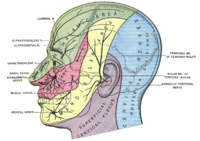
Photo from wikipedia
Invasive motor Cortex Stimulation (iMCS) was introduced in the 1990’s for the treatment of chronic neuropathic orofacial pain (CNOP), although its effectiveness remains doubtful. However, CNOP is known to be… Click to show full abstract
Invasive motor Cortex Stimulation (iMCS) was introduced in the 1990’s for the treatment of chronic neuropathic orofacial pain (CNOP), although its effectiveness remains doubtful. However, CNOP is known to be a heterogeneous group of orofacial pain disorders, which can lead to different responses to iMCS. Therefore, this paper investigated (1) whether the effectiveness of iMCS is significantly different among different CNOP disorders and (2) whether other confounding factors can be impacting iMCS results in CNOP. A systematic review and meta-analysis using a linear mixed-model was performed. Twenty-three papers were included, totaling 140 CNOP patients. Heterogeneity of the studies showed to be 55.8%. A visual analogue scale (VAS) measured median pain relief of 66.5% (ranging from 0–100%) was found. Linear mixed-model analysis showed that patients suffering from trigeminal neuralgia responded significantly more favorable to iMCS than patients suffering from dysfunctional pain syndromes (p = 0.030). Also, patients suffering from CNOP caused by (supra)nuclear lesions responded marginally significantly better to iMCS than patients suffering from CNOP due to trigeminal nerve lesions (p = 0.049). No other confounding factors were elucidated. This meta-analysis showed that patients suffering from trigeminal neuralgia and patients suffering from (supra)nuclear lesions causing CNOP responded significantly more favorable than others on iMCS. No other confounding factors were found relevant.
Journal Title: Scientific Reports
Year Published: 2020
Link to full text (if available)
Share on Social Media: Sign Up to like & get
recommendations!